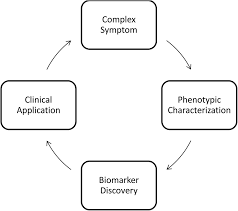The idea for the Symptom Science Center came about in 2016. Fitting into the vast NIH system, this center will allow researchers and clinicians from other branches to work towards personalized health with therapeutic and symptomatic treatments. Finally with the support of the intramural and extramural nursing science research organizations, this trans-NIH interdisciplinary resource has finally come to fruition.
Key program focus areas include: determining the phenotypes and biological underpinnings of symptoms for the development of health interventions and collecting common data elements that will be used as a resource by intramural and extramural researchers. Other goals of the center, according to Dr. Leory Saligan, Investigator, Chief of Symptom Science Center, will be to use “team science” to promote discovery and a strong collaborative environment and provide “mentorship to develop the next generation of nurses.”
Discussion of the symptom science model (as defined by Cashion & Grady - see right) was a central theme of many conversations throughout the event. Researchers at the NIH hope to use this model to:
 The Symptom Science Model
The Symptom Science Model
- Phenotype symptoms and understand that individual variability exists in the symptom experience
- Develop a personalized approach to symptom management, particularly through the use of patient reported outcomes (PROs)
- Determine the underlying problems to a variety of disease states
- Develop target therapies linked to symptoms
- Merge patient-centered data to be used as an interdisciplinary resource
The Symptom Science Center will conduct research across many diseases and focus areas. Some of the examples provided during the event included survivability and quality of life in brain and spine cancer patients; symptom clustering and symptom isolation in traumatic brain injury patients; and sleep deprivation in alcohol abuse disorder patients.
Discussion of treatments surrounded not only traditional drug therapies, but also holistic treatment methods such as mindfulness and exercise as means to reduce patient symptom burden. Symptoms were noted as PROs with an increasing amount submitted via electronic platforms. Using electronic platforms is an additional way to decrease patient burden and in many cases allows patients to participate in clinical studies despite location or transportation barriers.
Researchers are using these common data points in distinct ways to determine biological underpinnings and effective therapies. In some cases this information is used to change standards of care for many conditions, while in other cases symptoms and PROs are used to better understand the mechanisms behind disease. In this way, symptoms are utilized as indicators in a clinical to bench and back to clinical cycle, that improves patient outcomes and allieviates patient burdens.
The research that comes out of the center will apply to many types of science with wide impacts across many sectors. Dr. Michael Gottesman, Deputy Director for Intramural Research at the NIH stated that “understanding symptoms leads the path of precision medicine.” One of the strengths of the center will be the ability to focus on symptoms and not any one disease which “makes it easier for the rest of the NIH to tap into their expertise,” according to Dr. Gottesman.
At the end of this event, I was left with a feeling of hope for the future of healthcare. The top minds in medicine and science are proactively tackling the current burdens with the support of groundbreaking programs, such as the Symptom Science Center. I hope you will join me in following the efforts of researchers and the exciting discoveries that are to come.
To learn more, visit the NIH-NINR website.
Copyright © 2019 scienceboard.net



